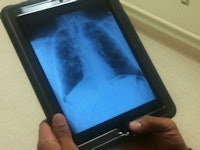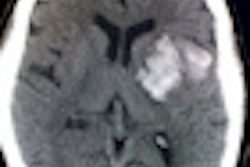
CHICAGO - Apple's iPad matched commercial-grade LCDs in evaluating for the presence or absence of tuberculosis (TB), according to research from the University of Maryland presented Monday at the RSNA annual meeting.
In a comparison study with commercial-grade PACS LCDs, the Baltimore study team found that the majority of radiologists subjectively found the iPad to be equal to or superior in image quality. In addition, they discovered no significant difference in the number of misdiagnoses on the iPad compared to commercial-grade monitors.
"The iPad holds great potential in mobile imaging, for secondary diagnosis and as an adjunct to an imaging report, and potentially screening for gross pathology," said presenter Frederick Weiss, MD.
In today's hospital environment, mobile technologies have become ubiquitous and the role of the radiologist has extended beyond the reading room, Weiss said. Believing that the iPad offers significant potential in mobile imaging, the research team sought to systematically assess, both subjectively and objectively, the iPad display as a diagnostic tool.
 |
| Screening chest x-ray on iPad. Image courtesy of Frederick Weiss, MD. |
Sampling a database of 500 cases for TB screening, the study team randomly selected 21 normal cases and nine positive cases. The original interpretations by a chest fellowship-trained attending on a PACS workstation were used as the gold standard for the study.
After the image window/level settings were optimized and validated by a chest fellowship-trained radiologist with more than 20 years of experience, the images were downloaded in JPEG format and stripped of identifying data, Weiss said.
The JPEG images were then transferred into the iPad's native photo viewer. The cases were randomized and placed into a PowerPoint show in JPEG format for reading on the LCD monitor, according to Weiss.
The 30 radiographs were provided to 10 radiologists (two general radiologist attendings and eight residents) for determining the presence of absence of TB. The participating radiologists were chosen based on their time availability to minimize disruption to department workflow, Weiss said.
The radiologists were asked only to characterize the study as positive or negative based on the suspicion of TB. Any other suspected findings on the film were to be ignored.
The radiologists first reviewed the iPad images and then examined the same images on the LCD an average of two days later to reduce recall bias. Using a Likert scale of 1 (unsatisfactory), 2 (poor), 3 (fair), 4 (good), and 5 (excellent), the radiologists also rated each display's image quality.
The researchers also recorded the iPad's positioning to determine if any variability existed between users. Both devices were compared using the same image format, file type, resolution, and size.
Monitor luminance, however, was not controlled for from the various radiology workstations used in the study, Weiss said. The luminance was set to what the radiologists had been using for their diagnostic studies.
|
In image quality ratings, 30% preferred the LCD while 20% preferred the iPad. The remaining 50% judged image quality to be equal for both displays. The iPad was rated as 4 (good) by 80% and 5 (excellent) by 20%. In contrast, the LCD monitor's image quality receiving a rating of 3 (fair) by 10%, 4 (good) by 50%, and 5 (excellent) by 40% of the participating radiologists.
"Subjectively, the majority of participants felt that the iPad was equal or superior to the LCD monitors used at a typical workstation with regard to the image quality and visualization," Weiss said.
In other findings, the researchers noted that one attending placed the iPad flat on the desk, while the other nine radiologists held the iPad in their left hand and rested it on their lap. They then used their right hand to flip through the images.
Overall, the iPad was not demonstrated to be either subjectively or objectively inferior to a standard LCD workstation monitor, Weiss said.
The researchers acknowledged a number of limitations in their findings, including the use of JPEG files (instead of DICOM) and the inability to window and level. There are a limited number of programs available on the iPad to view images and none to view DICOM images, Weiss said. And luminance wasn't controlled for.
Additional studies are required to determine the iPad's potential and limitations for primary diagnosis and for various imaging study types, Weiss said.
In other insights gleaned from the study, Weiss said that the iPad offers tremendous potential for use as an educational device for teaching findings to a clinical team, patient, or radiology resident. It also may be able to bring the radiologist closer to the clinical team and patient bedside as an educator and onsite consultant, he said.
"A world where radiologists use an iPad or similar tablet device may not be too far in the future," he said.
By Erik L. Ridley
AuntMinnie.com staff writer
November 29, 2010
Related Reading
iPhone can aid in triage of head injury patients, November 19, 2010
Report: iPad use surges in healthcare, November 16, 2010
Is the iPad radiology's dream device for mobile healthcare? June 24, 2010
TEPR founder sees big role for small systems in healthcare, June 24, 2010
iPhone app sufficient for determining stenosis on CCTA, March 29, 2010
Copyright © 2010 AuntMinnie.com




















